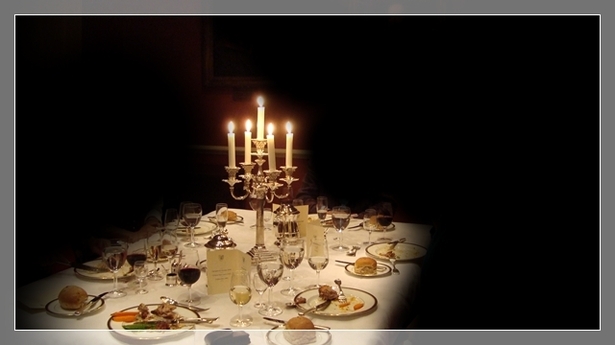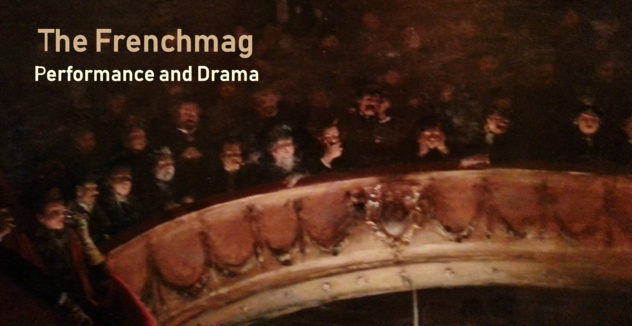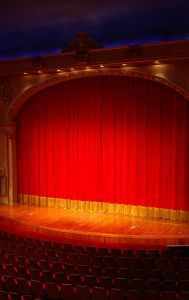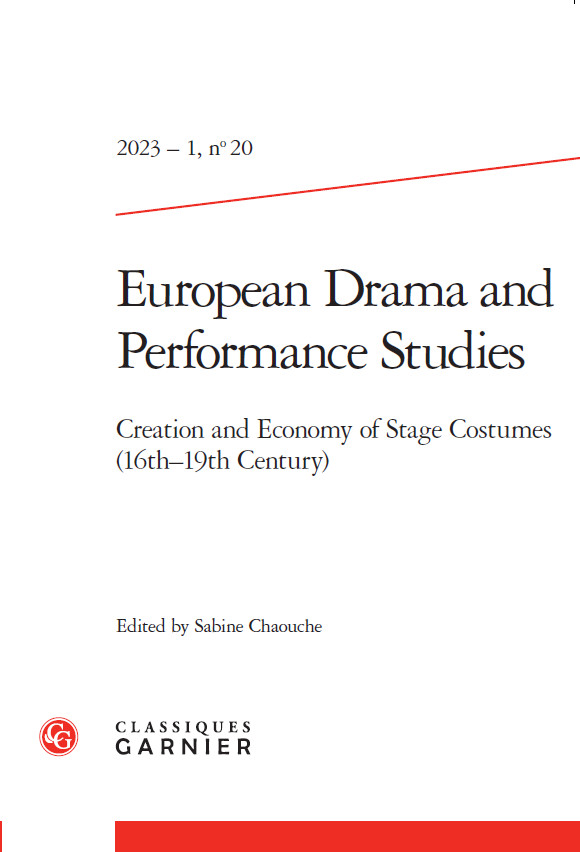
(c) Sabine Chaouche
It is not surprising to claim that daily objects were put on stage at the Comédie-Française during the period (for instance: jewellery; portraits; fashion accessories such as watches, mirrors, fans, ribbons, canes; linen such as table napkins, handkerchiefs; scientific or medical instruments such as syringes, spheres, globes; stationary such as paper, portfolios, books; or various objects such as a whip, a parasol, scissors, a pipe, needles and thread) and mixed with artificial ones such as fake noses or theatrical ones such as marottes (a fool’s head on a stick), a caduceus (a stick with snakes and wings, a symbol of medicine and/or Hermès), Italian masks (Harlequin, Harlequina, Punchinello, Doctor) or a magic wand.
However, food was one of the most amazing props.
Consumption was staged and emphasized through various plays such as The Bourgeois gentilhomme or Le Roi de Cocagne. The company never ordered objects made of papier mâché or cardboard. On the contrary it systematically and regularly ordered real meals from delicatessens.
However, food was one of the most amazing props.
Consumption was staged and emphasized through various plays such as The Bourgeois gentilhomme or Le Roi de Cocagne. The company never ordered objects made of papier mâché or cardboard. On the contrary it systematically and regularly ordered real meals from delicatessens.
Consumption
In 1760, Béjarne provided to the Comédie-Française biscuits, wine (muscat), macaroons for Heureusement by Rochon de Chabanne; biscuits, macaroons, wine, jam and sugared almonds for Le Tambour nocturne by Philippe Néricault-Destouches. Orders for specific food and desserts could be altered according to the whims (caprices) of the actors. Hence invoices could vary from time to time.
In 1762, the actors decided for instance to add marmalade, sugared almonds, pâte de fruits (dry jam) and sponge cake (biscuit de Savoie) to the list of props concerning Heureusement. The company chose to stage the Festin de pierre by Molière with a tableful including at first two starters, two courses, joints of meat (“des plats de rôt”), two pies and a dessert . They decided to slightly reduce the meal: two starters, one joint, a salad, some eggs, and three types of desserts (total amount: 15 liv .).
The Bourgeois gentilhomme by Molière, another play from the repertoire which put on stage the desire and an obsession for luxury of the main character Mr Jourdain, included also a supper and bottles of Champagne. It was cost 60 liv. per performance (we must remind here that a 4 pound loaf of bread cost 16 s.!) Actors had a real feast on the stage! The lifestyle of actors and their standard of living in the company were very high, which suggests how rich they were. This supper was ordered 38 times between 1757 and 1792. The costs were the same but actors ordered less food in the 1790s (50 liv., and afterwards 45 liv.).
One wonders whether wines were drunk on stage or not. Several documents (4 and 9 March 1781) reveal which types of desserts were enjoyed by actors or perhaps also the most fashionable ones during the period: biscuits, oranges, apples, pears, stewed fruits, toffee apples, and chocolate cakes. Sweets, which were luxury products and a symbol of affluence, reflected not only the splendour and an abundance of dishes bought by Mr Jourdain, but also the actors’ own wealth and taste for luxury.
In 1762, the actors decided for instance to add marmalade, sugared almonds, pâte de fruits (dry jam) and sponge cake (biscuit de Savoie) to the list of props concerning Heureusement. The company chose to stage the Festin de pierre by Molière with a tableful including at first two starters, two courses, joints of meat (“des plats de rôt”), two pies and a dessert . They decided to slightly reduce the meal: two starters, one joint, a salad, some eggs, and three types of desserts (total amount: 15 liv .).
The Bourgeois gentilhomme by Molière, another play from the repertoire which put on stage the desire and an obsession for luxury of the main character Mr Jourdain, included also a supper and bottles of Champagne. It was cost 60 liv. per performance (we must remind here that a 4 pound loaf of bread cost 16 s.!) Actors had a real feast on the stage! The lifestyle of actors and their standard of living in the company were very high, which suggests how rich they were. This supper was ordered 38 times between 1757 and 1792. The costs were the same but actors ordered less food in the 1790s (50 liv., and afterwards 45 liv.).
One wonders whether wines were drunk on stage or not. Several documents (4 and 9 March 1781) reveal which types of desserts were enjoyed by actors or perhaps also the most fashionable ones during the period: biscuits, oranges, apples, pears, stewed fruits, toffee apples, and chocolate cakes. Sweets, which were luxury products and a symbol of affluence, reflected not only the splendour and an abundance of dishes bought by Mr Jourdain, but also the actors’ own wealth and taste for luxury.
Sophisticated courses
They displayed their taste for sophisticated courses. If actors wanted to give to the stage a realistic or naturalist aspect and make the audience salivate by displaying delicacies and a full-flavoured cuisine (one can imagine that the smell of dishes would be enjoyed by the spectators standing in the pit), they liked also to have gourmet feasts.
Sugar was indeed a product of distinction, very fashionable at the time. Pastry cooks and jam producers were keen on inventing sophisticated desserts. Parisians developed a sweet tooth. In that sense, the company staged modernity and current trends. It unveiled succulent new products to audiences and favoured the presentation of luxury goods and food. It took into consideration the evolution of taste and culinary habits of the upper classes. Sugar and sweets were a sign of distinction and were constantly promoted through staging.
In Le Chevalier à Turin, the light meal was made of sweets (“entremets”), fruit, biscuits, macaroons, cream and a chocolate fricassee. Chocolate was also a sign of modernity and fashion. Big meals such as the dinner relating to La Partie de chasse de Henri IV consisted of 2 and half bottles of wine, bread, 2 chicken fricassee, chocolate and a month later, 3 and half bottles of wine, bread, breast of veal marinated in white wine. Desserts were the same. The number of bottles of wine was increased a few months later (in October). The actors would use three and half bottles of red wine, a half-bottle of white wine. Was all this really drunk during each performance, one wonders.
We know that some actors such as Mlle Dumesnil would drink a glass of wine and water before performing. Repeated orders concerning food for staging suggest that one way or another it was all consumed on a regular basis (actors may have sold on the leftovers which were called regrats but this is mere speculation ). It is not conceivable that they would waste such good food, especially in the 1780s when Parisians faced problems of supply.
Most of the orders relating to food show clearly that actors behaved mainly as consumers (practically nothing was rented at the Comédie-Française which constantly increased its collections). Papier-mâché began to be used at the end of the century for creating fake meals (a fake sucking pig on his dish is listed in the inventory made in 1815).
Sugar was indeed a product of distinction, very fashionable at the time. Pastry cooks and jam producers were keen on inventing sophisticated desserts. Parisians developed a sweet tooth. In that sense, the company staged modernity and current trends. It unveiled succulent new products to audiences and favoured the presentation of luxury goods and food. It took into consideration the evolution of taste and culinary habits of the upper classes. Sugar and sweets were a sign of distinction and were constantly promoted through staging.
In Le Chevalier à Turin, the light meal was made of sweets (“entremets”), fruit, biscuits, macaroons, cream and a chocolate fricassee. Chocolate was also a sign of modernity and fashion. Big meals such as the dinner relating to La Partie de chasse de Henri IV consisted of 2 and half bottles of wine, bread, 2 chicken fricassee, chocolate and a month later, 3 and half bottles of wine, bread, breast of veal marinated in white wine. Desserts were the same. The number of bottles of wine was increased a few months later (in October). The actors would use three and half bottles of red wine, a half-bottle of white wine. Was all this really drunk during each performance, one wonders.
We know that some actors such as Mlle Dumesnil would drink a glass of wine and water before performing. Repeated orders concerning food for staging suggest that one way or another it was all consumed on a regular basis (actors may have sold on the leftovers which were called regrats but this is mere speculation ). It is not conceivable that they would waste such good food, especially in the 1780s when Parisians faced problems of supply.
Most of the orders relating to food show clearly that actors behaved mainly as consumers (practically nothing was rented at the Comédie-Française which constantly increased its collections). Papier-mâché began to be used at the end of the century for creating fake meals (a fake sucking pig on his dish is listed in the inventory made in 1815).
Day to day diet of the actors
Food leads to a more in-depth study of the day-to-day diet of the actors.
Archival material and documents give information on beverages and meals eaten in restaurants, on price unit, taste for diversified products. They included tips (7 s., later 15 s.) and wood for heating (from 12 s. to 1 livre 8 s. depending on the number of guests).
Actors sometimes gave generous tips: in 1778, 3 liv. were paid to the waitresses and 2 liv. 8 s. to the cook!
Daily diet was constituted of wine (Bourgogne, Beaune wines or Muscat) and/or coffee, bread or brioche; meat (lamb, beef, free rang chicken, sweetbread, turkey, quail, young wild rabbit, pigeon, ham, cushion of veal, meat pies) but mainly fish (mussels, whiting filet or whiting quenelle, herring), soup or salad, sometimes omelettes or eggs, and desserts such as fruit (oranges, lemons, melon, peaches, apricots, plums, pears) or fruit in wine, cherry and strawberry compote, chocolate cream, biscuits, waffles, crème caramel, doughnuts.
Few vegetables come up (green beans, spinach, artichoke, cauliflowers).
In March 1703 they ordered for instance 14 bottles of wine (10 liv. 10 s.), bread, salad, one hundred oysters (3 liv.), a dish of cod (2 liv.), a dish of ray (3 liv.), 2 fried whitings (1 liv. 5 s.), a fried carp (2 liv.), salmon (2 liv.), 2 omelettes (3 liv.) and desserts (3 liv.). Actors would order and pay for luxury and expensive meals: 36 liv. in 1683; 18 liv. in the 1680s, 13 liv. 8 s., 35 liv. 4 s., and 30 liv. 12 s. in 1703, 61 liv. and 167 liv. 14 s. in 1778, 84 liv. 18 s. in 1780, 237 liv. 8 s. in 1786.
Some dinners or suppers were more like feasts and the prices suggest once again, that actors had a high standard of living. Different types of sophisticated food were ordered, sometimes in huge quantities (90 dozens of oysters and 30 dozens of pies were ordered in March 1778).
Sophisticated meals included free-range chicken stuffed with cucumber (4 liv. each), sturgeon with Champagne, cushion of veal with sorrel, cushion of veal with chicory (5 liv. 10 s.), artichoke à la glace (1 liv. 10 s), stuffed tongue (9 liv.), young partridges and cabbage (2 liv. 10 s.), sirloins (9 liv.), capon with cooking salt (8 liv.), turkey with black truffle (24 liv.), vole-au-vent (6 liv.), duck with turnips (6 liv.), fattened chicken (6 liv. 10 s.) or eel with tartar sauce (9 liv.), boiled beef in apple sauce (4 liv. 10 s.), sea perch à la maître d’hôtel (6 liv.), pike à la Chambord (12 liv.), cake à la turque (4 liv.), puffed omelette (2 liv.)…
Prices were extremely high.
We have to remember here that an unskilled worker was paid 15 s. for a working day. What was the evolution of prices, especially beverages and primary foodstuffs?
In the 1680s and at the beginning of the next century a bottle of red wine such as Beaune Wine and Bourgogne cost 15 s., in 1749 it cost 1 livre 10 s., in the 1770s and 1780s between 1 livre and 1 livre 10 s. Prices did not seem to have increased in restaurants, in the second part of the century. Some specific wines were more expensive such as Muscat, 2 liv. (1780s) or Bordeaux, 4 liv. (1780s).
Hot beverages were drunk during rehearsals. A cup of coffee cost 4 sols, as well as a cup of tea, and a hot chocolate was much more expensive: actors had to pay 7 s. In 1749, prices had changed: coffee cost 5 s and later in the 1780s, 15 s (unfortunately the number of cups was not mentioned here). The slow evolution of prices can be also noted through the cost of a capon which went up 5 fold: 1 livre at the beginning of the century versus 5 liv. in 1780. Other products became more expensive over the years: 100 oysters cost 3 liv., i.e. 3 s. per dozen, and in 1778, a dozen cost 8 s, whiting cost between 10 s. and 12 s. 5 d. in 1703 and 15 s. in 1780.
Overall, despite the rise in prices and financial problems in society, actors’ consumption shows that they managed their business very well since they could afford very expensive meals. They could also afford to go to cabarets and buy products from marchands de vin and delicatessens.
Sabine Chaouche
Archival material and documents give information on beverages and meals eaten in restaurants, on price unit, taste for diversified products. They included tips (7 s., later 15 s.) and wood for heating (from 12 s. to 1 livre 8 s. depending on the number of guests).
Actors sometimes gave generous tips: in 1778, 3 liv. were paid to the waitresses and 2 liv. 8 s. to the cook!
Daily diet was constituted of wine (Bourgogne, Beaune wines or Muscat) and/or coffee, bread or brioche; meat (lamb, beef, free rang chicken, sweetbread, turkey, quail, young wild rabbit, pigeon, ham, cushion of veal, meat pies) but mainly fish (mussels, whiting filet or whiting quenelle, herring), soup or salad, sometimes omelettes or eggs, and desserts such as fruit (oranges, lemons, melon, peaches, apricots, plums, pears) or fruit in wine, cherry and strawberry compote, chocolate cream, biscuits, waffles, crème caramel, doughnuts.
Few vegetables come up (green beans, spinach, artichoke, cauliflowers).
In March 1703 they ordered for instance 14 bottles of wine (10 liv. 10 s.), bread, salad, one hundred oysters (3 liv.), a dish of cod (2 liv.), a dish of ray (3 liv.), 2 fried whitings (1 liv. 5 s.), a fried carp (2 liv.), salmon (2 liv.), 2 omelettes (3 liv.) and desserts (3 liv.). Actors would order and pay for luxury and expensive meals: 36 liv. in 1683; 18 liv. in the 1680s, 13 liv. 8 s., 35 liv. 4 s., and 30 liv. 12 s. in 1703, 61 liv. and 167 liv. 14 s. in 1778, 84 liv. 18 s. in 1780, 237 liv. 8 s. in 1786.
Some dinners or suppers were more like feasts and the prices suggest once again, that actors had a high standard of living. Different types of sophisticated food were ordered, sometimes in huge quantities (90 dozens of oysters and 30 dozens of pies were ordered in March 1778).
Sophisticated meals included free-range chicken stuffed with cucumber (4 liv. each), sturgeon with Champagne, cushion of veal with sorrel, cushion of veal with chicory (5 liv. 10 s.), artichoke à la glace (1 liv. 10 s), stuffed tongue (9 liv.), young partridges and cabbage (2 liv. 10 s.), sirloins (9 liv.), capon with cooking salt (8 liv.), turkey with black truffle (24 liv.), vole-au-vent (6 liv.), duck with turnips (6 liv.), fattened chicken (6 liv. 10 s.) or eel with tartar sauce (9 liv.), boiled beef in apple sauce (4 liv. 10 s.), sea perch à la maître d’hôtel (6 liv.), pike à la Chambord (12 liv.), cake à la turque (4 liv.), puffed omelette (2 liv.)…
Prices were extremely high.
We have to remember here that an unskilled worker was paid 15 s. for a working day. What was the evolution of prices, especially beverages and primary foodstuffs?
In the 1680s and at the beginning of the next century a bottle of red wine such as Beaune Wine and Bourgogne cost 15 s., in 1749 it cost 1 livre 10 s., in the 1770s and 1780s between 1 livre and 1 livre 10 s. Prices did not seem to have increased in restaurants, in the second part of the century. Some specific wines were more expensive such as Muscat, 2 liv. (1780s) or Bordeaux, 4 liv. (1780s).
Hot beverages were drunk during rehearsals. A cup of coffee cost 4 sols, as well as a cup of tea, and a hot chocolate was much more expensive: actors had to pay 7 s. In 1749, prices had changed: coffee cost 5 s and later in the 1780s, 15 s (unfortunately the number of cups was not mentioned here). The slow evolution of prices can be also noted through the cost of a capon which went up 5 fold: 1 livre at the beginning of the century versus 5 liv. in 1780. Other products became more expensive over the years: 100 oysters cost 3 liv., i.e. 3 s. per dozen, and in 1778, a dozen cost 8 s, whiting cost between 10 s. and 12 s. 5 d. in 1703 and 15 s. in 1780.
Overall, despite the rise in prices and financial problems in society, actors’ consumption shows that they managed their business very well since they could afford very expensive meals. They could also afford to go to cabarets and buy products from marchands de vin and delicatessens.
Sabine Chaouche




